Taxation Law ATO's Circumstances for Declining Private Ruling Requests
VerifiedAdded on 2023/04/26
|9
|2431
|208
AI Summary
In this report we will discuss about law and below are the summaries point:-
Circumstances under which the ATO can decline to make a private ruling include situations where the ATO has already made a decision on the issue, where requested information has not been provided, where the ruling would cause prejudice or hindrance to the administration of law, where the commissioner chooses to exercise a power, where the ATO is not willing to make certain assumptions, and where the taxpayer fails to pay for an accurate valuation.
Gambling can be considered a business if carried out in a manner that reflects business practices, such as proper training, record keeping, and organization, as illustrated by the case of Babka, P. v. Commissioner of Taxation [1989] FCA 560.
The two accepted accounting methods for deriving income for tax purposes are the tax basis and accrual basis.
Taxation Ruling IT 2650 discusses the determination of residency for tax purposes, including the residency test.
In the given situation, the capital gain is calculated by subtracting the cost base from the cost proceeds from the sale of shares, resulting in a capital gain of $5000.
Contribute Materials
Your contribution can guide someone’s learning journey. Share your
documents today.

Running head: TAXATION LAW
Taxation Law
Name of the Student
Name of the University
Author Note
Taxation Law
Name of the Student
Name of the University
Author Note
Secure Best Marks with AI Grader
Need help grading? Try our AI Grader for instant feedback on your assignments.
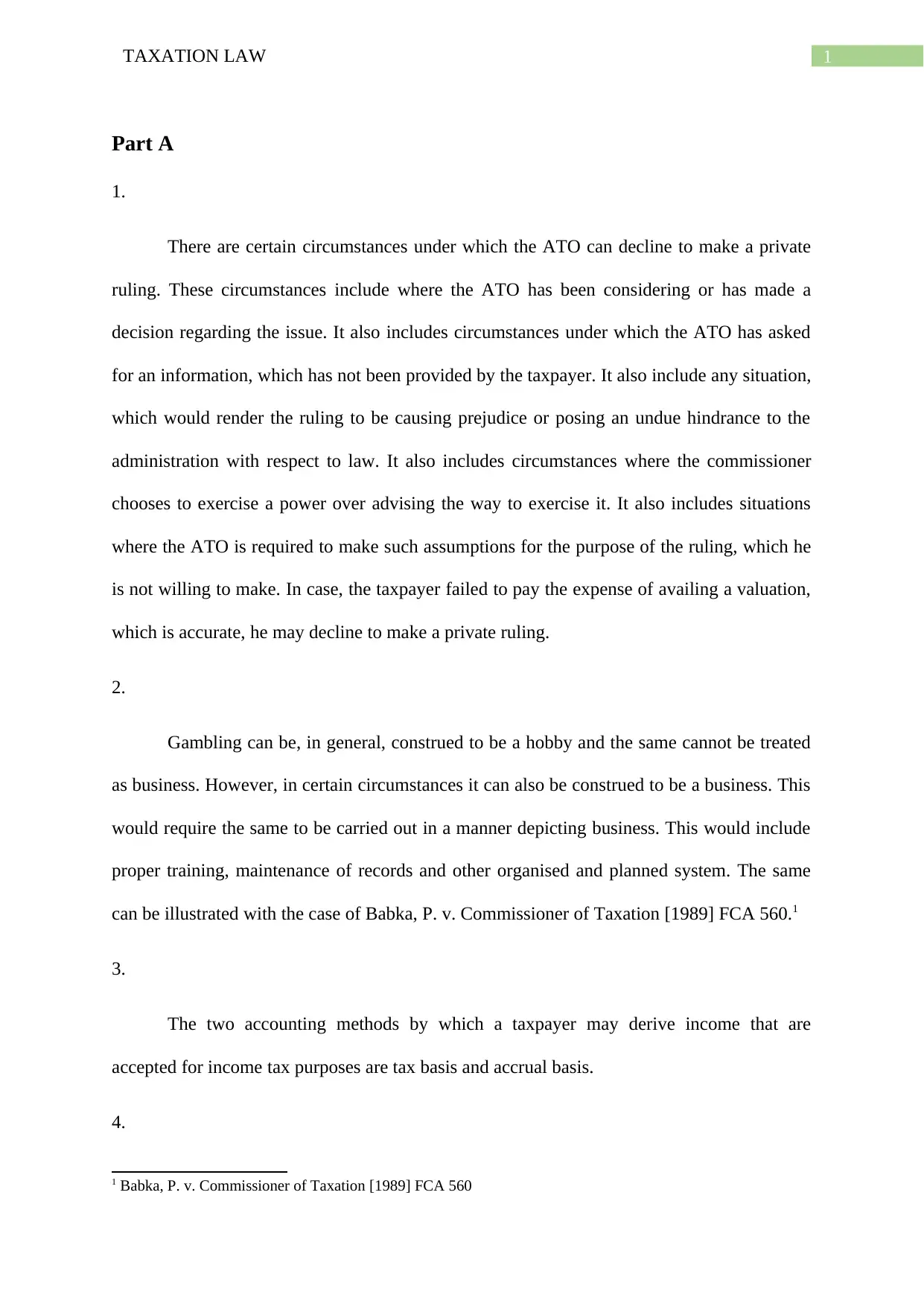
1TAXATION LAW
Part A
1.
There are certain circumstances under which the ATO can decline to make a private
ruling. These circumstances include where the ATO has been considering or has made a
decision regarding the issue. It also includes circumstances under which the ATO has asked
for an information, which has not been provided by the taxpayer. It also include any situation,
which would render the ruling to be causing prejudice or posing an undue hindrance to the
administration with respect to law. It also includes circumstances where the commissioner
chooses to exercise a power over advising the way to exercise it. It also includes situations
where the ATO is required to make such assumptions for the purpose of the ruling, which he
is not willing to make. In case, the taxpayer failed to pay the expense of availing a valuation,
which is accurate, he may decline to make a private ruling.
2.
Gambling can be, in general, construed to be a hobby and the same cannot be treated
as business. However, in certain circumstances it can also be construed to be a business. This
would require the same to be carried out in a manner depicting business. This would include
proper training, maintenance of records and other organised and planned system. The same
can be illustrated with the case of Babka, P. v. Commissioner of Taxation [1989] FCA 560.1
3.
The two accounting methods by which a taxpayer may derive income that are
accepted for income tax purposes are tax basis and accrual basis.
4.
1 Babka, P. v. Commissioner of Taxation [1989] FCA 560
Part A
1.
There are certain circumstances under which the ATO can decline to make a private
ruling. These circumstances include where the ATO has been considering or has made a
decision regarding the issue. It also includes circumstances under which the ATO has asked
for an information, which has not been provided by the taxpayer. It also include any situation,
which would render the ruling to be causing prejudice or posing an undue hindrance to the
administration with respect to law. It also includes circumstances where the commissioner
chooses to exercise a power over advising the way to exercise it. It also includes situations
where the ATO is required to make such assumptions for the purpose of the ruling, which he
is not willing to make. In case, the taxpayer failed to pay the expense of availing a valuation,
which is accurate, he may decline to make a private ruling.
2.
Gambling can be, in general, construed to be a hobby and the same cannot be treated
as business. However, in certain circumstances it can also be construed to be a business. This
would require the same to be carried out in a manner depicting business. This would include
proper training, maintenance of records and other organised and planned system. The same
can be illustrated with the case of Babka, P. v. Commissioner of Taxation [1989] FCA 560.1
3.
The two accounting methods by which a taxpayer may derive income that are
accepted for income tax purposes are tax basis and accrual basis.
4.
1 Babka, P. v. Commissioner of Taxation [1989] FCA 560
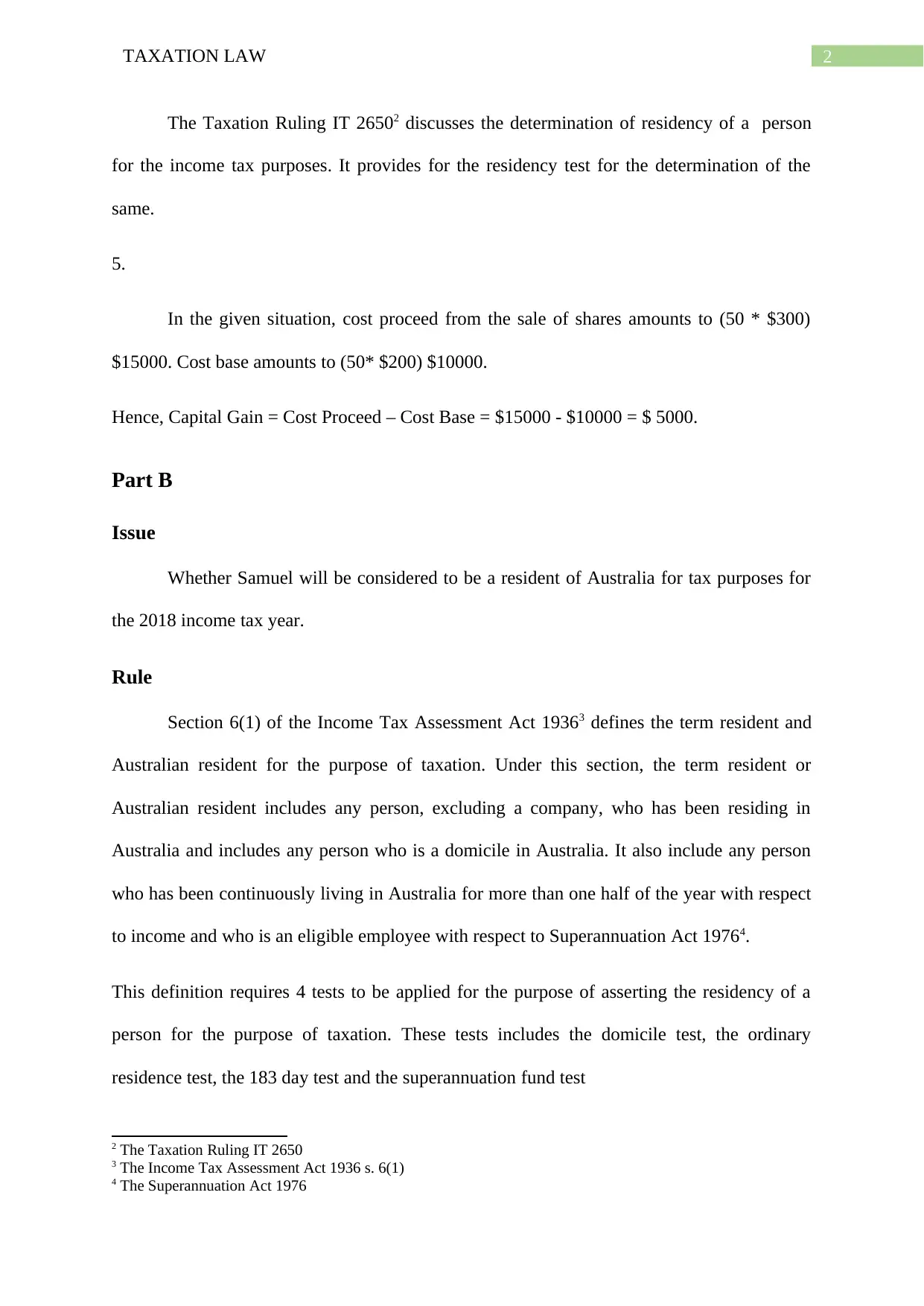
2TAXATION LAW
The Taxation Ruling IT 26502 discusses the determination of residency of a person
for the income tax purposes. It provides for the residency test for the determination of the
same.
5.
In the given situation, cost proceed from the sale of shares amounts to (50 * $300)
$15000. Cost base amounts to (50* $200) $10000.
Hence, Capital Gain = Cost Proceed – Cost Base = $15000 - $10000 = $ 5000.
Part B
Issue
Whether Samuel will be considered to be a resident of Australia for tax purposes for
the 2018 income tax year.
Rule
Section 6(1) of the Income Tax Assessment Act 19363 defines the term resident and
Australian resident for the purpose of taxation. Under this section, the term resident or
Australian resident includes any person, excluding a company, who has been residing in
Australia and includes any person who is a domicile in Australia. It also include any person
who has been continuously living in Australia for more than one half of the year with respect
to income and who is an eligible employee with respect to Superannuation Act 19764.
This definition requires 4 tests to be applied for the purpose of asserting the residency of a
person for the purpose of taxation. These tests includes the domicile test, the ordinary
residence test, the 183 day test and the superannuation fund test
2 The Taxation Ruling IT 2650
3 The Income Tax Assessment Act 1936 s. 6(1)
4 The Superannuation Act 1976
The Taxation Ruling IT 26502 discusses the determination of residency of a person
for the income tax purposes. It provides for the residency test for the determination of the
same.
5.
In the given situation, cost proceed from the sale of shares amounts to (50 * $300)
$15000. Cost base amounts to (50* $200) $10000.
Hence, Capital Gain = Cost Proceed – Cost Base = $15000 - $10000 = $ 5000.
Part B
Issue
Whether Samuel will be considered to be a resident of Australia for tax purposes for
the 2018 income tax year.
Rule
Section 6(1) of the Income Tax Assessment Act 19363 defines the term resident and
Australian resident for the purpose of taxation. Under this section, the term resident or
Australian resident includes any person, excluding a company, who has been residing in
Australia and includes any person who is a domicile in Australia. It also include any person
who has been continuously living in Australia for more than one half of the year with respect
to income and who is an eligible employee with respect to Superannuation Act 19764.
This definition requires 4 tests to be applied for the purpose of asserting the residency of a
person for the purpose of taxation. These tests includes the domicile test, the ordinary
residence test, the 183 day test and the superannuation fund test
2 The Taxation Ruling IT 2650
3 The Income Tax Assessment Act 1936 s. 6(1)
4 The Superannuation Act 1976

3TAXATION LAW
Tax ruling 2650 provides for the domicile test that is required to be applied to ascertain the
residency of a person in Australia for the purpose of the assessment of tax. Under this test a
person is considered to be a resident in Australia, if it is evident that his domicile is in
Australia. However, this can be treated as otherwise if the authority is satisfied that the
person in question has a place of abode of permanent nature situated outside Australia. This
test begins with two steps, firstly the determination of the domicile of a person is required to
be carried out if a person does not have a domicile in Australia he will not be treated as an
Australian resident. However, if the person is evident to have a domicile in Australia the
second step of the test is required to be applied. In the second step it needs to be satisfied that
the person who has been a domicile in Australia does not have any permanent place of abode
located outside Australia. If these two steps are satisfied a person can be construed to be
resident in Australia for the purpose of this test. Domicile can be construed as a permanent
home or a place to live, which can be construed to be e more than just residence. The same
can be illustrated with the case of Buswell v. I.R.C (1974) 2 All E.R. 5205. The term
permanent place of abode does not constitute an everlasting place of abode, but it is more of a
comparative term, which is used in comparison of temporary place of abode. The same can
be illustrated with the case of R v. Hammond (1852) 117 E.R. 14776. This test is applied
when a person has went to overseas country for the purpose of employment over an extended
period of time and has to be assessed for the purpose of taxation in Australia. This can be
illustrated with the case of Henderson v. Henderson [1965] 1 All E.R.1797.
In case the domicile test has been satisfied by the person, he needs to be assessed under the
183 day rule for the purpose of evaluating his status of resident in Australia. For the purpose
of being rendered an Australian resident, the person needs to be present in Australia for more
than 183 day. However, this test will not hold good if the person has his usual place of abode
5 Buswell v. I.R.C (1974) 2 All E.R. 520
6 R v. Hammond (1852) 117 E.R. 1477
7 Henderson v. Henderson [1965] 1 All E.R.179
Tax ruling 2650 provides for the domicile test that is required to be applied to ascertain the
residency of a person in Australia for the purpose of the assessment of tax. Under this test a
person is considered to be a resident in Australia, if it is evident that his domicile is in
Australia. However, this can be treated as otherwise if the authority is satisfied that the
person in question has a place of abode of permanent nature situated outside Australia. This
test begins with two steps, firstly the determination of the domicile of a person is required to
be carried out if a person does not have a domicile in Australia he will not be treated as an
Australian resident. However, if the person is evident to have a domicile in Australia the
second step of the test is required to be applied. In the second step it needs to be satisfied that
the person who has been a domicile in Australia does not have any permanent place of abode
located outside Australia. If these two steps are satisfied a person can be construed to be
resident in Australia for the purpose of this test. Domicile can be construed as a permanent
home or a place to live, which can be construed to be e more than just residence. The same
can be illustrated with the case of Buswell v. I.R.C (1974) 2 All E.R. 5205. The term
permanent place of abode does not constitute an everlasting place of abode, but it is more of a
comparative term, which is used in comparison of temporary place of abode. The same can
be illustrated with the case of R v. Hammond (1852) 117 E.R. 14776. This test is applied
when a person has went to overseas country for the purpose of employment over an extended
period of time and has to be assessed for the purpose of taxation in Australia. This can be
illustrated with the case of Henderson v. Henderson [1965] 1 All E.R.1797.
In case the domicile test has been satisfied by the person, he needs to be assessed under the
183 day rule for the purpose of evaluating his status of resident in Australia. For the purpose
of being rendered an Australian resident, the person needs to be present in Australia for more
than 183 day. However, this test will not hold good if the person has his usual place of abode
5 Buswell v. I.R.C (1974) 2 All E.R. 520
6 R v. Hammond (1852) 117 E.R. 1477
7 Henderson v. Henderson [1965] 1 All E.R.179
Secure Best Marks with AI Grader
Need help grading? Try our AI Grader for instant feedback on your assignments.
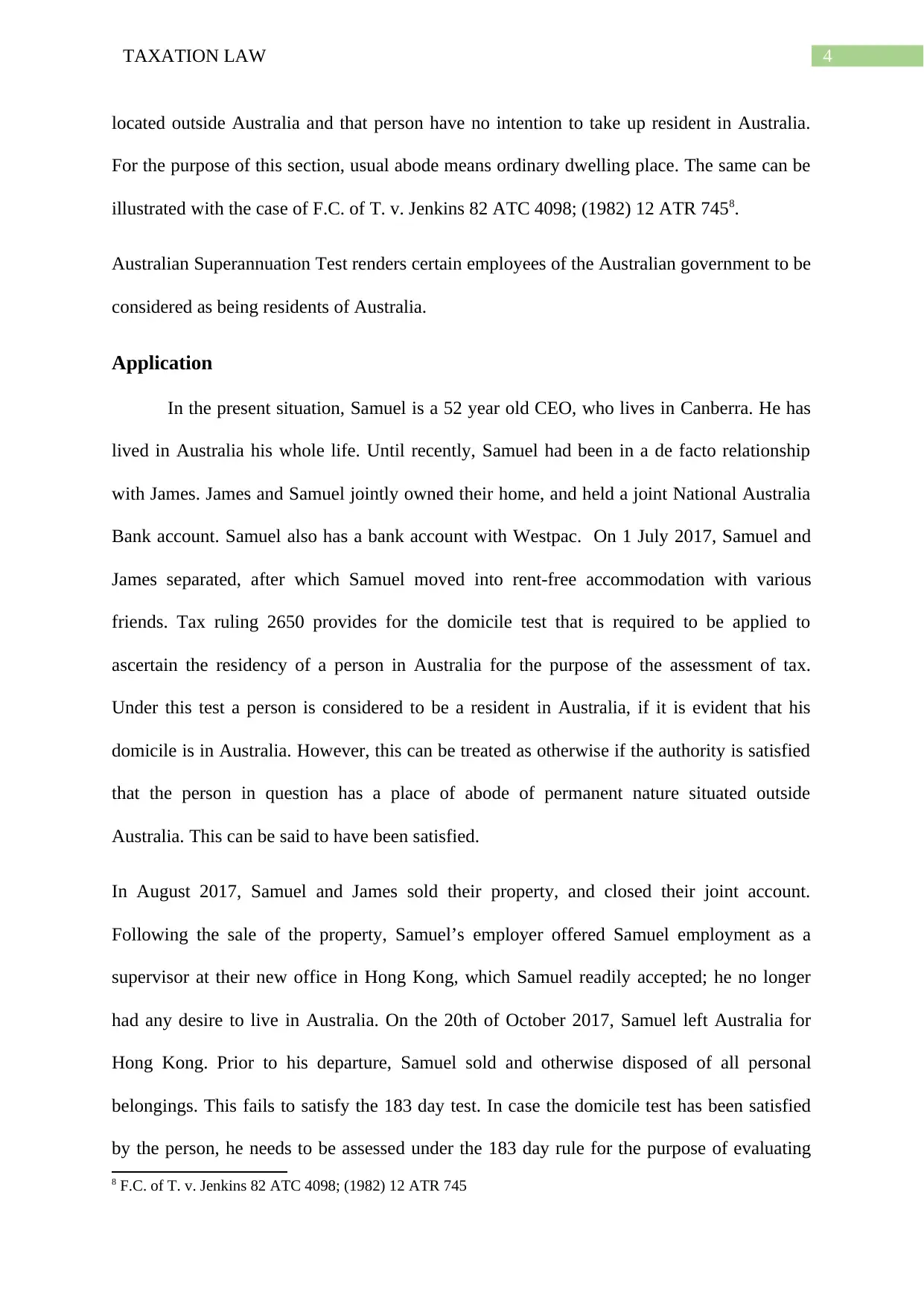
4TAXATION LAW
located outside Australia and that person have no intention to take up resident in Australia.
For the purpose of this section, usual abode means ordinary dwelling place. The same can be
illustrated with the case of F.C. of T. v. Jenkins 82 ATC 4098; (1982) 12 ATR 7458.
Australian Superannuation Test renders certain employees of the Australian government to be
considered as being residents of Australia.
Application
In the present situation, Samuel is a 52 year old CEO, who lives in Canberra. He has
lived in Australia his whole life. Until recently, Samuel had been in a de facto relationship
with James. James and Samuel jointly owned their home, and held a joint National Australia
Bank account. Samuel also has a bank account with Westpac. On 1 July 2017, Samuel and
James separated, after which Samuel moved into rent-free accommodation with various
friends. Tax ruling 2650 provides for the domicile test that is required to be applied to
ascertain the residency of a person in Australia for the purpose of the assessment of tax.
Under this test a person is considered to be a resident in Australia, if it is evident that his
domicile is in Australia. However, this can be treated as otherwise if the authority is satisfied
that the person in question has a place of abode of permanent nature situated outside
Australia. This can be said to have been satisfied.
In August 2017, Samuel and James sold their property, and closed their joint account.
Following the sale of the property, Samuel’s employer offered Samuel employment as a
supervisor at their new office in Hong Kong, which Samuel readily accepted; he no longer
had any desire to live in Australia. On the 20th of October 2017, Samuel left Australia for
Hong Kong. Prior to his departure, Samuel sold and otherwise disposed of all personal
belongings. This fails to satisfy the 183 day test. In case the domicile test has been satisfied
by the person, he needs to be assessed under the 183 day rule for the purpose of evaluating
8 F.C. of T. v. Jenkins 82 ATC 4098; (1982) 12 ATR 745
located outside Australia and that person have no intention to take up resident in Australia.
For the purpose of this section, usual abode means ordinary dwelling place. The same can be
illustrated with the case of F.C. of T. v. Jenkins 82 ATC 4098; (1982) 12 ATR 7458.
Australian Superannuation Test renders certain employees of the Australian government to be
considered as being residents of Australia.
Application
In the present situation, Samuel is a 52 year old CEO, who lives in Canberra. He has
lived in Australia his whole life. Until recently, Samuel had been in a de facto relationship
with James. James and Samuel jointly owned their home, and held a joint National Australia
Bank account. Samuel also has a bank account with Westpac. On 1 July 2017, Samuel and
James separated, after which Samuel moved into rent-free accommodation with various
friends. Tax ruling 2650 provides for the domicile test that is required to be applied to
ascertain the residency of a person in Australia for the purpose of the assessment of tax.
Under this test a person is considered to be a resident in Australia, if it is evident that his
domicile is in Australia. However, this can be treated as otherwise if the authority is satisfied
that the person in question has a place of abode of permanent nature situated outside
Australia. This can be said to have been satisfied.
In August 2017, Samuel and James sold their property, and closed their joint account.
Following the sale of the property, Samuel’s employer offered Samuel employment as a
supervisor at their new office in Hong Kong, which Samuel readily accepted; he no longer
had any desire to live in Australia. On the 20th of October 2017, Samuel left Australia for
Hong Kong. Prior to his departure, Samuel sold and otherwise disposed of all personal
belongings. This fails to satisfy the 183 day test. In case the domicile test has been satisfied
by the person, he needs to be assessed under the 183 day rule for the purpose of evaluating
8 F.C. of T. v. Jenkins 82 ATC 4098; (1982) 12 ATR 745
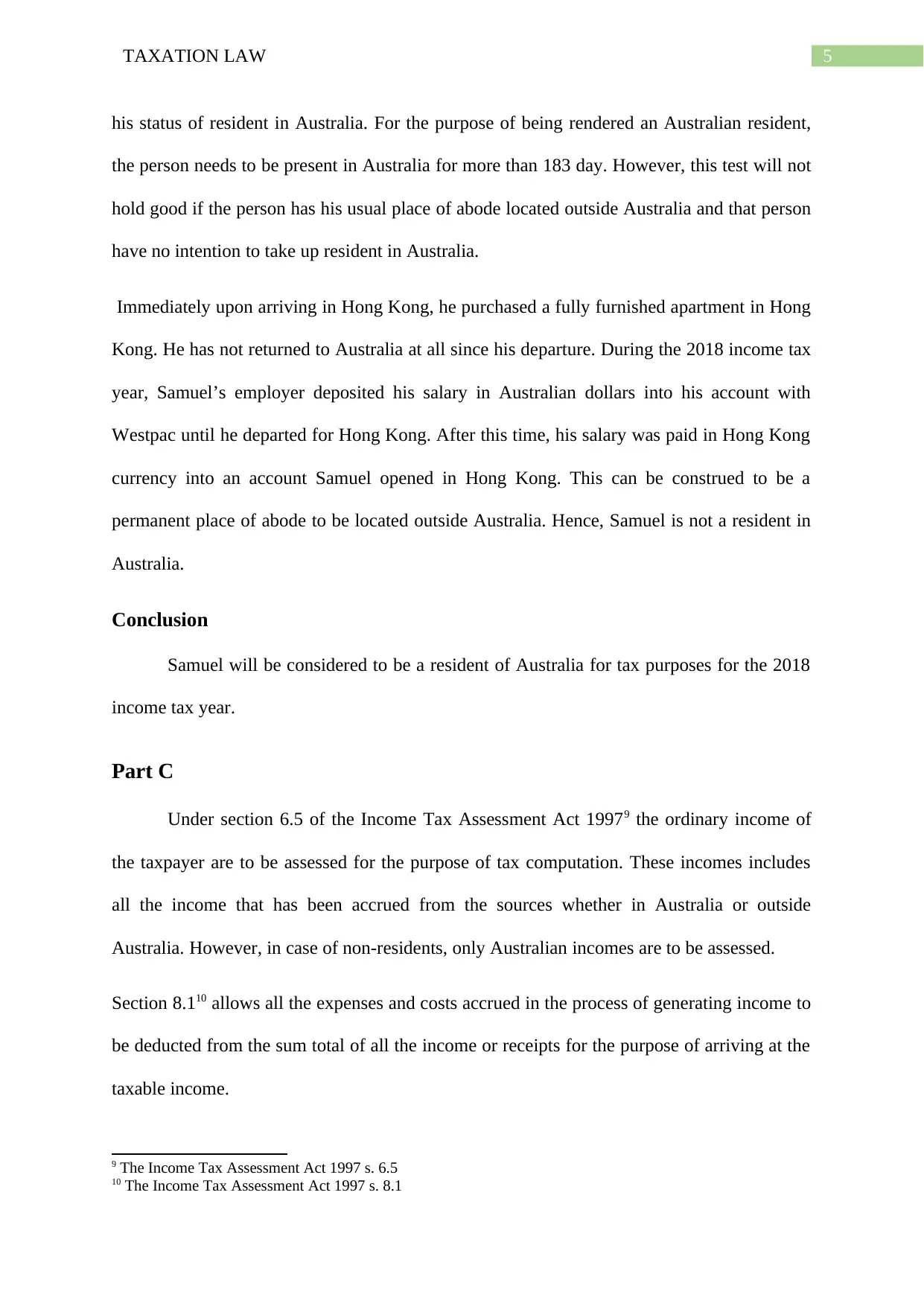
5TAXATION LAW
his status of resident in Australia. For the purpose of being rendered an Australian resident,
the person needs to be present in Australia for more than 183 day. However, this test will not
hold good if the person has his usual place of abode located outside Australia and that person
have no intention to take up resident in Australia.
Immediately upon arriving in Hong Kong, he purchased a fully furnished apartment in Hong
Kong. He has not returned to Australia at all since his departure. During the 2018 income tax
year, Samuel’s employer deposited his salary in Australian dollars into his account with
Westpac until he departed for Hong Kong. After this time, his salary was paid in Hong Kong
currency into an account Samuel opened in Hong Kong. This can be construed to be a
permanent place of abode to be located outside Australia. Hence, Samuel is not a resident in
Australia.
Conclusion
Samuel will be considered to be a resident of Australia for tax purposes for the 2018
income tax year.
Part C
Under section 6.5 of the Income Tax Assessment Act 19979 the ordinary income of
the taxpayer are to be assessed for the purpose of tax computation. These incomes includes
all the income that has been accrued from the sources whether in Australia or outside
Australia. However, in case of non-residents, only Australian incomes are to be assessed.
Section 8.110 allows all the expenses and costs accrued in the process of generating income to
be deducted from the sum total of all the income or receipts for the purpose of arriving at the
taxable income.
9 The Income Tax Assessment Act 1997 s. 6.5
10 The Income Tax Assessment Act 1997 s. 8.1
his status of resident in Australia. For the purpose of being rendered an Australian resident,
the person needs to be present in Australia for more than 183 day. However, this test will not
hold good if the person has his usual place of abode located outside Australia and that person
have no intention to take up resident in Australia.
Immediately upon arriving in Hong Kong, he purchased a fully furnished apartment in Hong
Kong. He has not returned to Australia at all since his departure. During the 2018 income tax
year, Samuel’s employer deposited his salary in Australian dollars into his account with
Westpac until he departed for Hong Kong. After this time, his salary was paid in Hong Kong
currency into an account Samuel opened in Hong Kong. This can be construed to be a
permanent place of abode to be located outside Australia. Hence, Samuel is not a resident in
Australia.
Conclusion
Samuel will be considered to be a resident of Australia for tax purposes for the 2018
income tax year.
Part C
Under section 6.5 of the Income Tax Assessment Act 19979 the ordinary income of
the taxpayer are to be assessed for the purpose of tax computation. These incomes includes
all the income that has been accrued from the sources whether in Australia or outside
Australia. However, in case of non-residents, only Australian incomes are to be assessed.
Section 8.110 allows all the expenses and costs accrued in the process of generating income to
be deducted from the sum total of all the income or receipts for the purpose of arriving at the
taxable income.
9 The Income Tax Assessment Act 1997 s. 6.5
10 The Income Tax Assessment Act 1997 s. 8.1
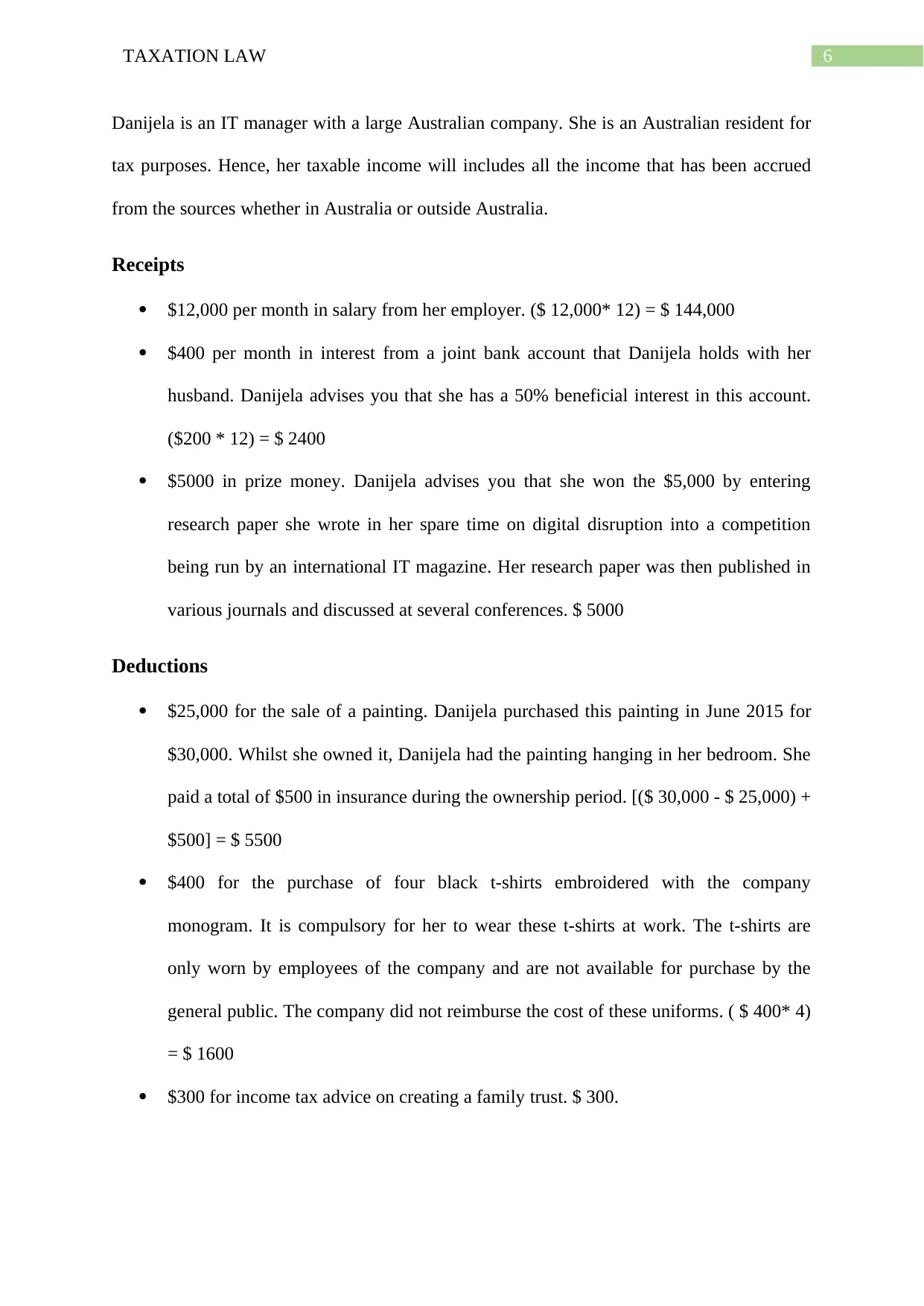
6TAXATION LAW
Danijela is an IT manager with a large Australian company. She is an Australian resident for
tax purposes. Hence, her taxable income will includes all the income that has been accrued
from the sources whether in Australia or outside Australia.
Receipts
$12,000 per month in salary from her employer. ($ 12,000* 12) = $ 144,000
$400 per month in interest from a joint bank account that Danijela holds with her
husband. Danijela advises you that she has a 50% beneficial interest in this account.
($200 * 12) = $ 2400
$5000 in prize money. Danijela advises you that she won the $5,000 by entering
research paper she wrote in her spare time on digital disruption into a competition
being run by an international IT magazine. Her research paper was then published in
various journals and discussed at several conferences. $ 5000
Deductions
$25,000 for the sale of a painting. Danijela purchased this painting in June 2015 for
$30,000. Whilst she owned it, Danijela had the painting hanging in her bedroom. She
paid a total of $500 in insurance during the ownership period. [($ 30,000 - $ 25,000) +
$500] = $ 5500
$400 for the purchase of four black t-shirts embroidered with the company
monogram. It is compulsory for her to wear these t-shirts at work. The t-shirts are
only worn by employees of the company and are not available for purchase by the
general public. The company did not reimburse the cost of these uniforms. ( $ 400* 4)
= $ 1600
$300 for income tax advice on creating a family trust. $ 300.
Danijela is an IT manager with a large Australian company. She is an Australian resident for
tax purposes. Hence, her taxable income will includes all the income that has been accrued
from the sources whether in Australia or outside Australia.
Receipts
$12,000 per month in salary from her employer. ($ 12,000* 12) = $ 144,000
$400 per month in interest from a joint bank account that Danijela holds with her
husband. Danijela advises you that she has a 50% beneficial interest in this account.
($200 * 12) = $ 2400
$5000 in prize money. Danijela advises you that she won the $5,000 by entering
research paper she wrote in her spare time on digital disruption into a competition
being run by an international IT magazine. Her research paper was then published in
various journals and discussed at several conferences. $ 5000
Deductions
$25,000 for the sale of a painting. Danijela purchased this painting in June 2015 for
$30,000. Whilst she owned it, Danijela had the painting hanging in her bedroom. She
paid a total of $500 in insurance during the ownership period. [($ 30,000 - $ 25,000) +
$500] = $ 5500
$400 for the purchase of four black t-shirts embroidered with the company
monogram. It is compulsory for her to wear these t-shirts at work. The t-shirts are
only worn by employees of the company and are not available for purchase by the
general public. The company did not reimburse the cost of these uniforms. ( $ 400* 4)
= $ 1600
$300 for income tax advice on creating a family trust. $ 300.
Paraphrase This Document
Need a fresh take? Get an instant paraphrase of this document with our AI Paraphraser
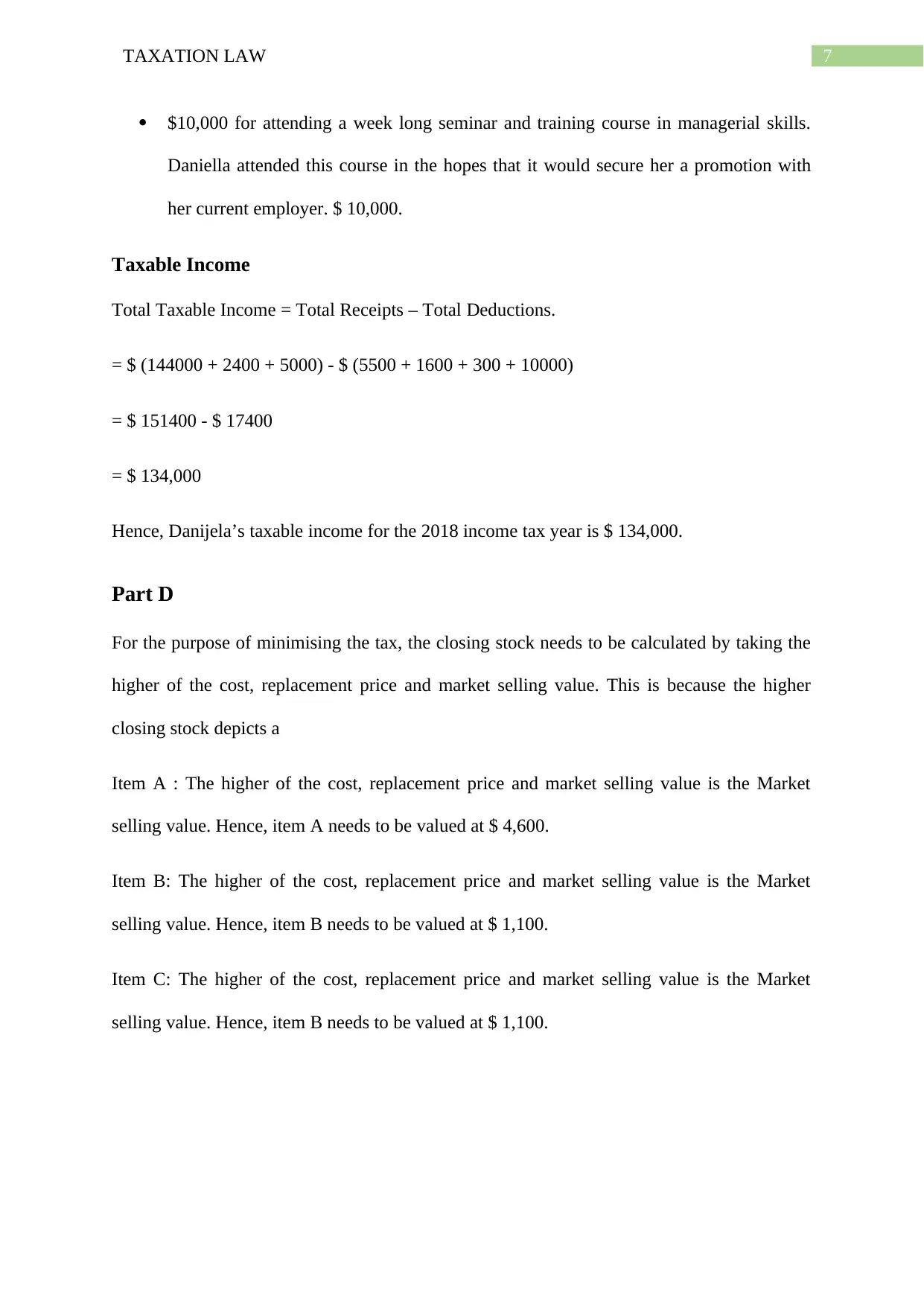
7TAXATION LAW
$10,000 for attending a week long seminar and training course in managerial skills.
Daniella attended this course in the hopes that it would secure her a promotion with
her current employer. $ 10,000.
Taxable Income
Total Taxable Income = Total Receipts – Total Deductions.
= $ (144000 + 2400 + 5000) - $ (5500 + 1600 + 300 + 10000)
= $ 151400 - $ 17400
= $ 134,000
Hence, Danijela’s taxable income for the 2018 income tax year is $ 134,000.
Part D
For the purpose of minimising the tax, the closing stock needs to be calculated by taking the
higher of the cost, replacement price and market selling value. This is because the higher
closing stock depicts a
Item A : The higher of the cost, replacement price and market selling value is the Market
selling value. Hence, item A needs to be valued at $ 4,600.
Item B: The higher of the cost, replacement price and market selling value is the Market
selling value. Hence, item B needs to be valued at $ 1,100.
Item C: The higher of the cost, replacement price and market selling value is the Market
selling value. Hence, item B needs to be valued at $ 1,100.
$10,000 for attending a week long seminar and training course in managerial skills.
Daniella attended this course in the hopes that it would secure her a promotion with
her current employer. $ 10,000.
Taxable Income
Total Taxable Income = Total Receipts – Total Deductions.
= $ (144000 + 2400 + 5000) - $ (5500 + 1600 + 300 + 10000)
= $ 151400 - $ 17400
= $ 134,000
Hence, Danijela’s taxable income for the 2018 income tax year is $ 134,000.
Part D
For the purpose of minimising the tax, the closing stock needs to be calculated by taking the
higher of the cost, replacement price and market selling value. This is because the higher
closing stock depicts a
Item A : The higher of the cost, replacement price and market selling value is the Market
selling value. Hence, item A needs to be valued at $ 4,600.
Item B: The higher of the cost, replacement price and market selling value is the Market
selling value. Hence, item B needs to be valued at $ 1,100.
Item C: The higher of the cost, replacement price and market selling value is the Market
selling value. Hence, item B needs to be valued at $ 1,100.
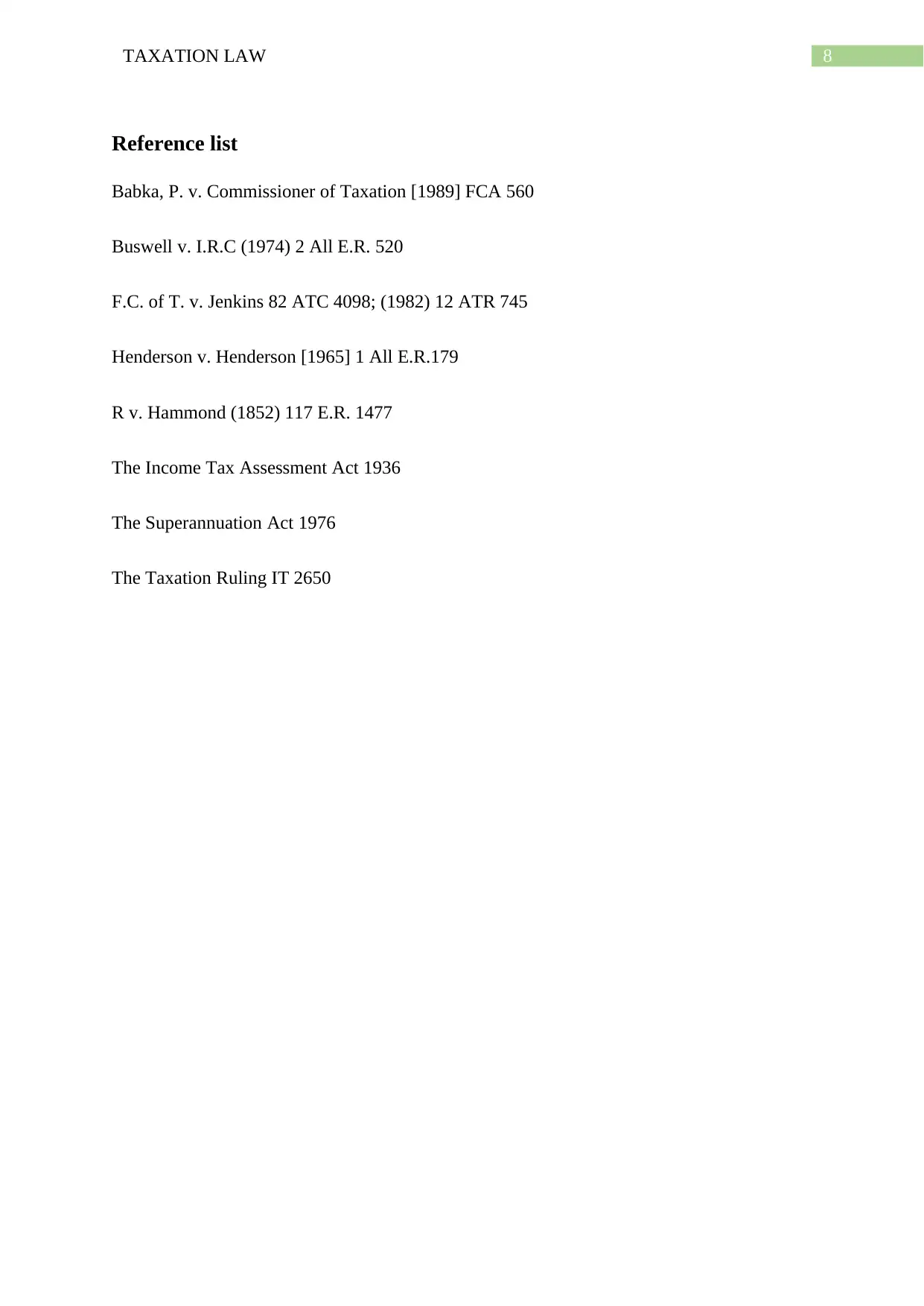
8TAXATION LAW
Reference list
Babka, P. v. Commissioner of Taxation [1989] FCA 560
Buswell v. I.R.C (1974) 2 All E.R. 520
F.C. of T. v. Jenkins 82 ATC 4098; (1982) 12 ATR 745
Henderson v. Henderson [1965] 1 All E.R.179
R v. Hammond (1852) 117 E.R. 1477
The Income Tax Assessment Act 1936
The Superannuation Act 1976
The Taxation Ruling IT 2650
Reference list
Babka, P. v. Commissioner of Taxation [1989] FCA 560
Buswell v. I.R.C (1974) 2 All E.R. 520
F.C. of T. v. Jenkins 82 ATC 4098; (1982) 12 ATR 745
Henderson v. Henderson [1965] 1 All E.R.179
R v. Hammond (1852) 117 E.R. 1477
The Income Tax Assessment Act 1936
The Superannuation Act 1976
The Taxation Ruling IT 2650
1 out of 9
Related Documents
Your All-in-One AI-Powered Toolkit for Academic Success.
+13062052269
info@desklib.com
Available 24*7 on WhatsApp / Email
![[object Object]](/_next/static/media/star-bottom.7253800d.svg)
Unlock your academic potential
© 2024 | Zucol Services PVT LTD | All rights reserved.





